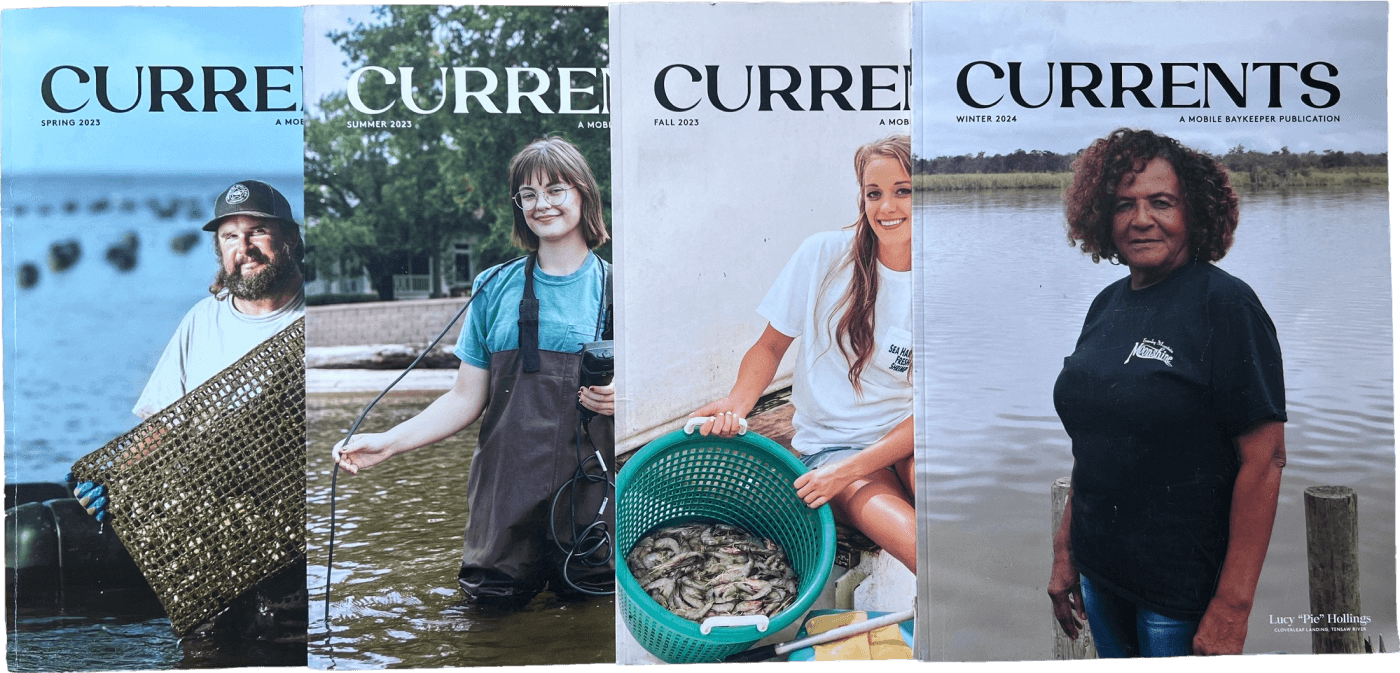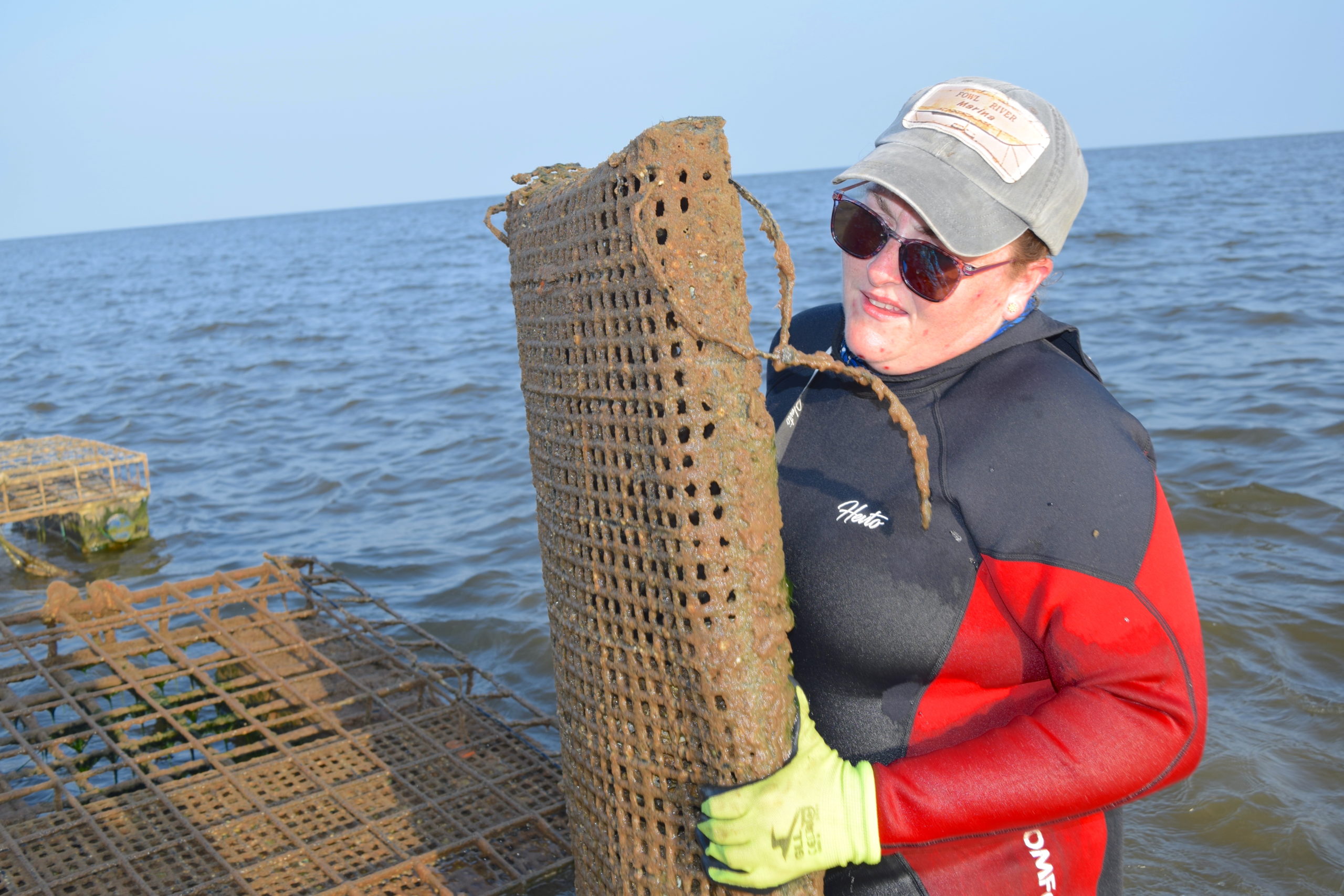
This article is from the fall edition of Mobile Baykeeper’s print quarterly, CURRENTS. The magazine is mailed to active members who have given more than $50 in 2023. To get on the magazine’s mailing list, donate here.
By Cassie Bates | Photos by Caine O’Rear
Bama Bay Oyster Farm may be dubbed a “boutique” operation, but don’t let that word fool you: its caretakers are anything but. You see, it takes a certain boldness to run an oyster farm. You have the elements to contend with on a daily basis, and for all the joys that come with working on the water, there is also a lot of heartbreak. If you spend a little time at Bama Bay, you’ll see that it requires a a great deal of love, energy, and patience for an oyster to go from seed to shell.
We recently caught up with Jackie Wilson, the head of the Bama Bay enterprise. Jackie also has experience working as a field and laboratory technician at the Dauphin Island Sea Lab for the University of South Alabama Marine Science Department Fisheries Lab. She continues running Bama Bay Oyster Farm in memory of her late partners and advisors, Bette Kulman and Dottie Teague Lawley.
I met you on a study abroad trip in the Bahamas and, at the time, we didn’t know what we wanted to do with our lives, but we knew we wanted to be on the water. What led you specifically into the oyster industry?
Our neighbor, Andy DePaola. As a kid, I did not know what he did, but when he retired from the FDA, he gifted my little sister an oyster cage with about 500 to 1,000 baby oysters in it. My sister, who was only 12 or 13 at the time, called me over and said, “Jackie Boo, I have oyster seed!” And I thought to myself, how can you have seeds of oysters? And the next thing I knew, Andy was telling me all about how oysters clean the Bay and how you can make a living from growing and selling them. One thing led to another and then it just evolved to the point where my entire life is dedicated to oysters, quite literally. I live, eat, breathe, sweat, and love oysters.
Co-owning and operating the first and only female-run oyster farm in the state of Alabama is an impressive feat. Have you had opportunities to mentor other women and girls who might have a passion for shellfish?
I have had a lot of encouragement and interest from up-and-coming females in the marine science field and in school, but I worry that they do not understand how difficult this is. It’s a struggle to even have a seat at the table.
I had one woman reach out to me out of the blue from Pensacola. She said she was sick of her 9-to-5 job in hospitality. She would shuck oysters on the clock and one day she told me that the thought crossed her mind, “Where do oysters even come from?” She started doing research and found out that you can farm oysters and even algae or kelp. I consulted with her for a while to encourage her to give aquaculture a try, and that introduced me to the feeling of helping others establish their goals in this industry.
How many oysters do y’all generate in a year, and where can people find your oysters on the market?
Currently, our batches are taking a while to reach market size, so we don’t have a bunch going out the door. We can have anywhere from 1,000 to over 3,000 at a time, but unfortunately it seems like nobody wants to deal with our oysters. I don’t know why, sometimes I think it may have been because of Dottie’s reputation. She just didn’t take anything from anyone, she was a businesswoman her whole life, and she often dealt with being treated differently. People would screw her over just because they had made their mind up about the value of her operation with it being small-scale.
People tend to want to deal with larger farms, if you are not harvesting tens to thousands, you just are not worth their time. We currently don’t have the funds to acquire refrigerated transportation for our oysters, and we have worked with some processors in the past, but they are no longer in the picture. I work a 40-hour-plus job and have a family, so if there were ways to simplify and streamline paperwork, and a better means to transport oysters, that would make a big difference for us.
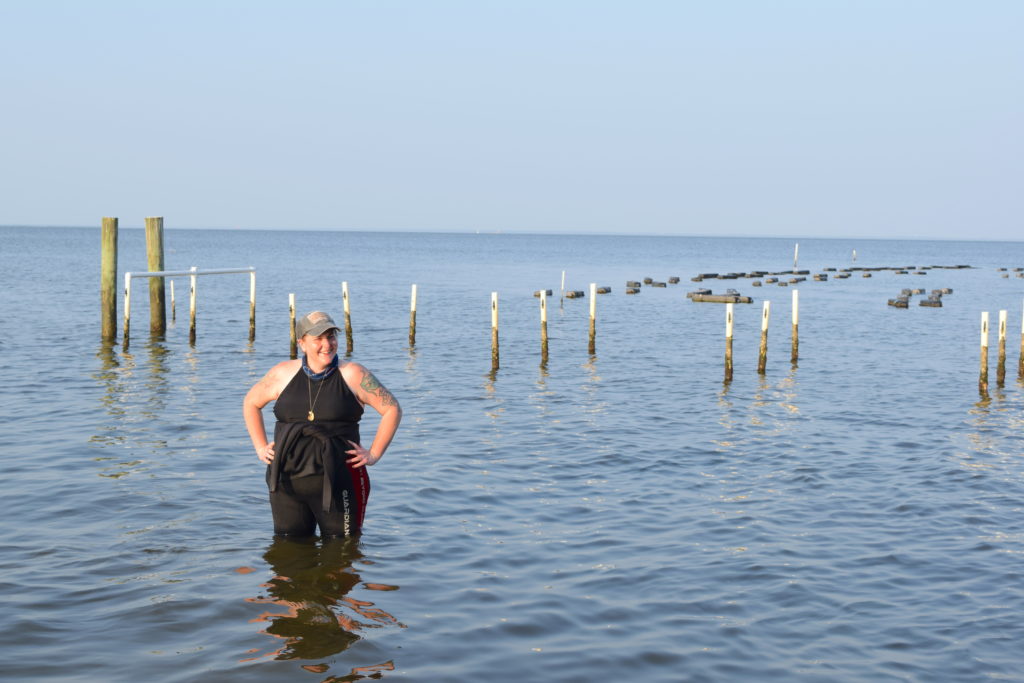
The past several years have been hard on Bama Bay and you all have experienced a lot of loss. Between the natural disasters and the pandemic, what has kept your family and partners going?
Dottie always told me that if there were oysters in the water, she was doing her job. That’s my mantra. I literally say that to myself every day. I grew up half a mile from here. I can see my grandfather’s house from here, where my parents live now. And you know how much I love this Bay. I joke all the time that I wasn’t born but that I walked out of this muddy water, and that it literally shaped who I am. There is not a day that goes by without me looking at this water or touching it. This Bay is everything to me and it was everything to her, and I think that is why we got this farm.
Dottie was my “Oyster Mama,” and everything we did wasn’t necessarily for a commercial sale; it was for the improvement of this beautiful body of water. I think that the love she showed other people, and the inclusion and acceptance she generated, just made you feel like you were the most important person in the moment. I guess knowing her allowed us to love the Bay as much as she did.
We always say that this is our chosen family, but we are family. There’s no doubt about it. Bette and Dottie, they’re still here. After we lost everything in 2017 from the low saline event and then from high temperatures, she said, “If I can just harvest one more time, I’ll be okay.” That’s why we did a memorial harvest after they passed. I talk to her every day (we scattered her ashes right over there). Whenever the pelicans visit the dock, I think of them too. They tend to fly in groups of three, so I like to think that they are Dottie, Bette and myself. You know, Dottie made me save a pelican once off the Dauphin Island bridge. I have a picture of her just plucking treble hooks out of this poor baby, and I like to think that it is still flying around somewhere out there for her.
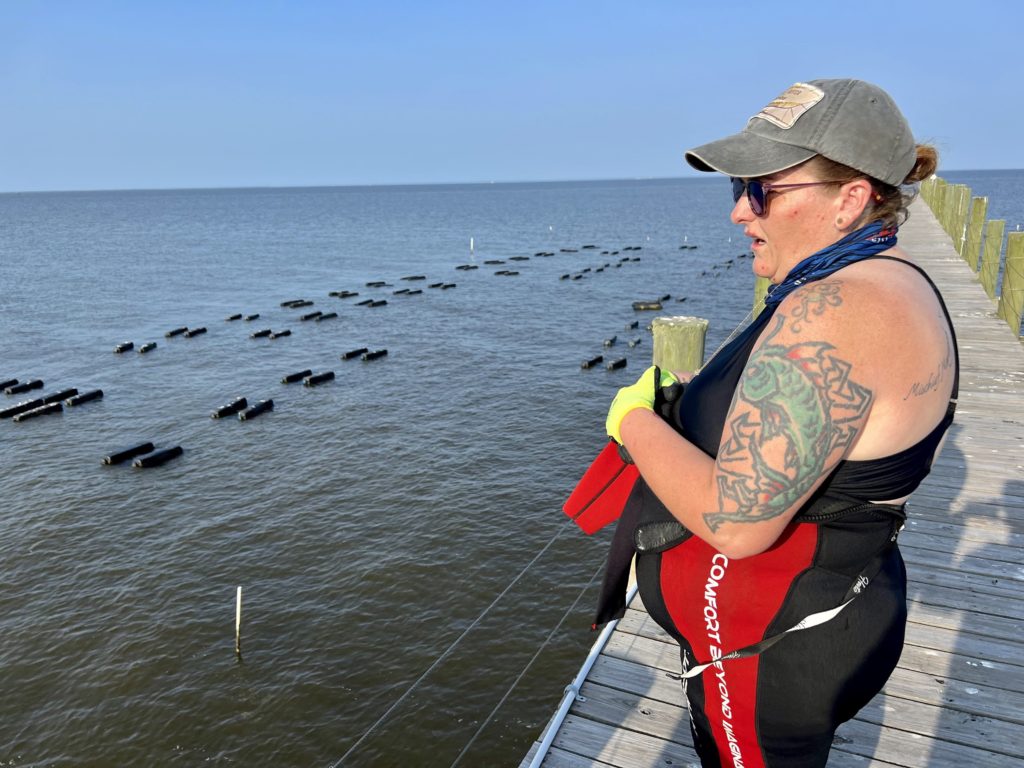
You grew up playing in the very same waters that your oysters are growing in today. What are some of your favorite memories on the western shore and how has it changed since you were little?
It has changed a lot. I remember my great-grandfather made this bell, and he used it to call my dad and my grandpa in from Bayfront Road and Hollinger’s Island when they were little. When they sold that house, my dad snagged that bell for us, and we would hear it ring and come in from playing in the Bay. So, the mission for us kids was to get as far down the beach as we could before we heard the bell and along the way we would pick up soft-shell crabs and stash them in our pockets. They were everywhere, and sometimes we would sneak out at night with a lantern, and we would flounder and crab until mom found out we were gone. She would pat us down for all the crabs but would usually miss one or two. They would inevitably end up in the washing machine the next day and cause a stir, but it was so fun.
We would play in the seagrass, when there used to be seagrass everywhere here, but I haven’t seen it since 1997. My dad said there used to be seagrass all the way from the mouth of Dog River to Galliard Island and that you could walk barefoot through it to the island. I never correlated the gradual loss of the crabs and flounder with the loss of the seagrass until I started studying marine science, but I started to see a change. I haven’t caught a soft-shell crab here since the early 2000s.
What do you perceive to be the biggest challenge that oyster-men and -women are going to be facing in the next 10 to 20 years?
Climate change. I am helping with studies at the Dauphin Island Sea Lab now where we are looking at the intersection of shell degradation and water conditions like pH, salinity, and temperature. If the water is too acidic, oysters can’t build their shells properly, and it also affects their recruitment and settlement. There are also more heat waves and hypoxia events, turbidity from the shipping channel, and pollution runoff from construction like the Paradise Found RV Park just around the corner from us … there are just so many things impacting oysters.
The sad reality is that human impacts will not stop, and my nieces and nephews will never know Mobile Bay like I knew it, or like I will never know it again. My goal is to preach the Oyster Gospel, so I think if we have more oysters in the water, and if everyone could have a few bags around the Bay, we could really do something for the Bay’s health.
Does your envisioned future for Bama Bay involve any community engagement?
Getting undergraduates with the University of South Alabama’s Marine Science Student Association out here on the farm is my favorite thing, because a lot of these kids are from the Midwest, and they’ve never actually seen a large body of water. I mean, these are marine science majors, and some of them have never seen a blue crab before. This will be our eighth year working with them and I am looking forward to that this fall.
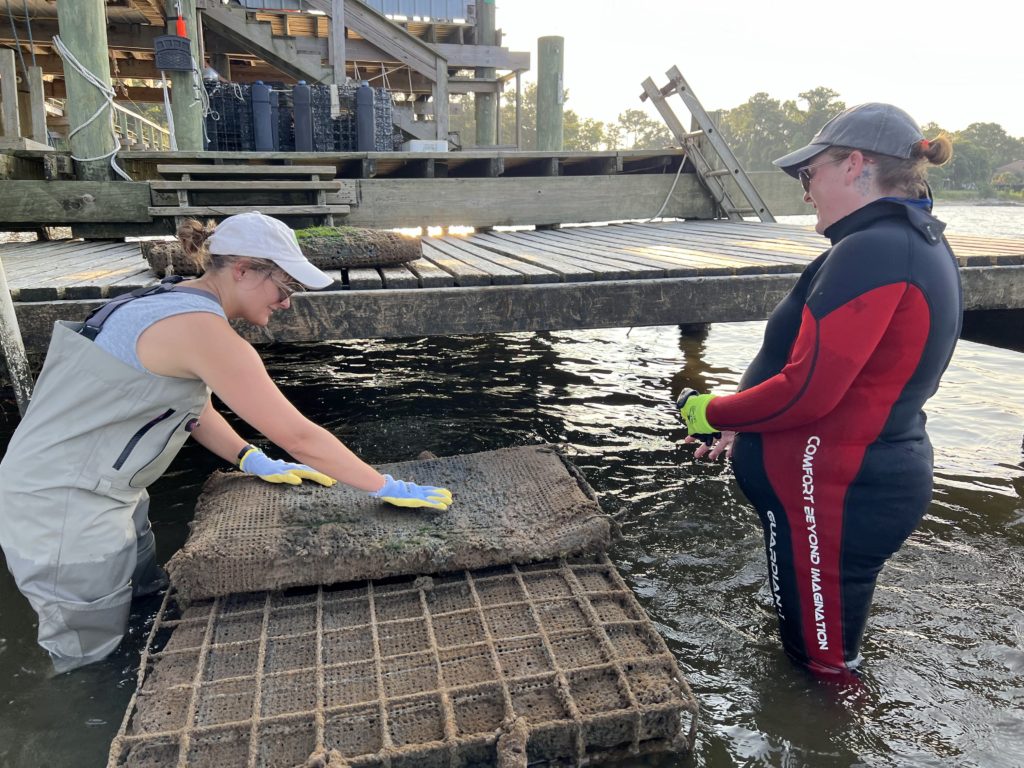
Long-term, when I finish graduate school, I want to switch from a commercial operation to female agriculture consultation or education outreach for K-12 audiences and just share oysters with people and instill this knowledge that you must be a steward of this watershed. I would love to provide a space for graduate and undergraduate students to conduct research and advise them on experimental design.
I can help create prototype gear and just combine my fisheries studies with hands-on practical farming knowledge to come up with unique and inventive solutions to bridge the gap between theory and application. I want to create a space that is helping oyster survival in the bay. I want to facilitate and encourage others and say, “Do you need space, time, knowledge?” I am here; let’s do this.
As a woman on the water and in husbandry science, what’s next for you?
I want to encourage future generations and see them, and our current generation, take accountability for the Bay of the Holy Spirit and spread the Oyster Gospel. I want to walk out here, and then never leave this office. That is my end goal, just to stay right here.
You can learn more about how to get involved with Bama Bay Oyster Farm here.
